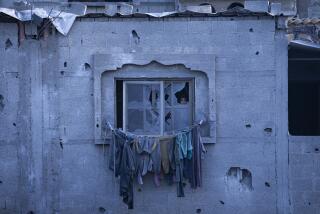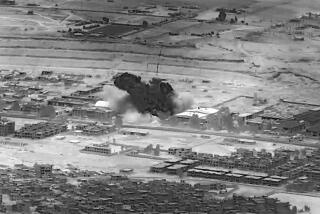More than ever, insurgents are targeting U.S. forces
- Share via
BAGHDAD — For U.S. troops, October was a month of gritty skirmishes against fighters religiously motivated to risk their lives during the holy Muslim month of Ramadan.
October’s death toll, the highest for American forces in nearly two years, came during a period without conventional battles or catastrophic helicopter crashes.
For the record:
12:00 a.m. Nov. 2, 2006 For The Record
Los Angeles Times Thursday November 02, 2006 Home Edition Main News Part A Page 2 National Desk 0 inches; 37 words Type of Material: Correction
Iraq war casualties: The right edge of a map in Wednesday’s Section A that showed the hometowns of slain U.S. troops did not print, causing the name of the Massachusetts city of Malden to appear as Malder.
Rather, the 103 troops killed in Baghdad and across Iraq were victims of a steady onslaught of assaults, primarily by their longtime nemeses, Sunni Arab insurgents.
The number of attacks on American forces increased in October to unprecedented levels, U.S. military officials said.
“There has been a much more considered effort to specifically target coalition and Iraqi security forces,” Army Maj. Gen. William B. Caldwell IV, the spokesman for U.S.-led forces in Iraq, told reporters in Baghdad as the month wore on. “There has been a steady increase in the number of attacks specifically against security forces.”
There were 224 Iraqi security forces and 1,315 civilians killed in October.
It was a month in which U.S. forces were shot by snipers, struck by rocket-propelled grenades or lured into ambushes where they were sprayed with automatic-weapon fire from the AK-47s found in so many Iraqi homes.
But improvised explosive devices left along roads remained the weapon of choice for Iraq’s anti-American insurgency.
Despite jamming devices, tactical adjustments and the increased armoring of military vehicles, at least 51 of the U.S. deaths resulted from makeshift bombs detonated by remote control from a comfortable distance.
At least 43 deaths occurred in Baghdad, indicating a shifting focus away from the Sunni heartland toward Iraq’s capital “due to our more deliberate presence, more active involvement out there,” Caldwell said last week.
U.S. forces were more exposed than usual in Baghdad because of an ongoing offensive aimed at taking back the streets from the forces of sectarian warfare -- Sunni insurgents and Shiite Muslim militiamen, some allied with officials of the Shiite-dominated Iraqi government.
Though U.S. officials say the Shiite militias dominating Iraq’s south pose the biggest long-term threat to the country’s stability, the vast majority of the Americans were killed in Sunni-dominated areas.
The deaths in Baghdad occurred largely in Sunni-dominated neighborhoods on the west side. Thirty-seven American troops died west of Baghdad, in largely Sunni Al Anbar province. Sunni insurgents in the Euphrates River towns and cities of Iraq’s desert hinterlands deem U.S. troops an occupation force and the Baghdad government, run by the nation’s long-subjugated Shiite majority, little more than an American puppet.
The Marine Corps, unlike the Army, does not release information about the exact location or cause of deaths. Senior Marine officers think such information could help the enemy. The Marines, in public announcements, described at least 18 of the October deaths as “hostile” incidents in Al Anbar.
Most officials acknowledge that many of the Marine casualties in October occurred in Ramadi, the rundown provincial capital where insurgents have intimidated most Iraqi government workers into fleeing. Marines face daily threats from roadside bombs, snipers and assaults on their fortified bases.
“It’s combat nearly every day,” one Marine officer said, speaking on condition of anonymity. “Ramadi is where the terrorists want to establish their capital. They’re armed and they’re relentless.”
Another 17 Americans were killed in Sunni Arab areas north of Baghdad, in and around the provincial capitals of Tikrit, Baqubah, Mosul and Kirkuk, where Kurds and Sunni Arabs are fighting for dominance.
October’s death toll was the highest since the month preceding Iraq’s Jan. 31, 2005, elections.
On average, the American troops who died last month were men in their mid-20s, many on patrols or combat missions in and around a jittery Baghdad full of trash fires, dust storms and morning explosions.
Typical of the fatalities was Staff Sgt. Kevin M. Witte, 27, of Beardsley, a farming town in western Minnesota, along the South Dakota line.
He died Oct. 20 in Baghdad when an improvised explosive device detonated near his vehicle during a combat patrol.
Such roadside bomb explosions in densely populated areas smash windows and cause panic among Iraqi pedestrians, drivers and residents. Wild gunfire erupts. Alarmed and confused, their eardrums shattered, U.S. troops start shooting or receive small-arms fire from hidden insurgents.
Helicopters arrive to scour the terrain for culprits and attend to the wounded and dying. Bradley fighting vehicles block off the area as the injured are ferried to medical facilities.
A dead soldier’s comrades gather at outdoor ceremonies. The silence lingers after his name is read in a commemorative roll call. And a trumpeter plays taps.
*
Times staff writer Tony Perry in San Diego contributed to this report.
*
Begin text of infobox
103 - U.S. troops killed in Iraq in October
137 - Highest monthly total, in November 2004
636 - Number killed in 2006
2,813 - Total U.S. deaths in the war
*
Sources: Defense Department, Times reporting
More to Read
Sign up for Essential California
The most important California stories and recommendations in your inbox every morning.
You may occasionally receive promotional content from the Los Angeles Times.










